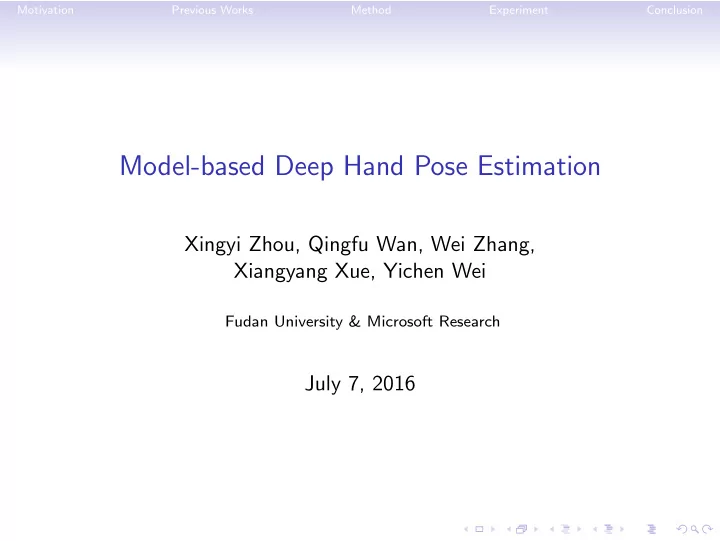

Motivation Previous Works Method Experiment Conclusion Model-based Deep Hand Pose Estimation Xingyi Zhou, Qingfu Wan, Wei Zhang, Xiangyang Xue, Yichen Wei Fudan University & Microsoft Research July 7, 2016
Motivation Previous Works Method Experiment Conclusion Motivation • Various applications in human-computer interaction, augmented reality and driving analysis ... • Widely used commercial depth sensors. • Hot research topic. Goal Given a depth image of human hand, estimate accurate 3D joint locations.
Motivation Previous Works Method Experiment Conclusion Generative Approaches Model-based, synthesize and optimize. • [Oikonomidis et al., 2011] • Could be highly accurate • [Makris et al., 2015] • • Guaranteed to be valid [Qian et al., 2014] • [Tagliasacchi et al., 2015] • Slow • [Sharp et al., 2015]
Motivation Previous Works Method Experiment Conclusion Discriminative Approaches Learning-based, learn a direct regression function. Random Forest Regressor • [Keskin et al., 2012] • [Tang et al., 2013] • Much more efficient • [Xu and Cheng, 2013] • Results are coarse • [Sun et al., 2015] • Violate hand geometry • [Li et al., 2015] CNN Regressor • [Oberweger et al., 2015a]
Motivation Previous Works Method Experiment Conclusion Hybrid Approaches Use discriminative method for initialization, and model-based refinement. • [Tompson et al., 2014] • [Oberweger et al., 2015b] • [Dong et al., 2015] • [Sridhar et al., 2015]
Motivation Previous Works Method Experiment Conclusion Model-based Deep Hand Pose Estimation • We designed a novel layer in deep learning that realized the non-linear forward kinematic mapping from joint angles to joint locations. • We add a physical constraint as a multi-task loss in the objective function to ensure physical validity.
Motivation Previous Works Method Experiment Conclusion Hand Model A hand model is a map from hand pose parameters Θ to 3D joint locations Y • F : R D → R J × 3 • D = 26: The DOF of human hand • J = 23: The number of key joints • Y = F (Θ) • θ i ∈ [ θ i , θ i ]
Motivation Previous Works Method Experiment Conclusion Forward Kinematics � Rot φ t ( θ t ) × Trans φ t ( θ t ))[0 , 0 , 0 , 1] ⊤ p u ( k ) = ( t ∈ Pa ( u )
Motivation Previous Works Method Experiment Conclusion Deep Learning with a Hand Model Layer Joint location loss: L jt (Θ) = 1 2 ||F (Θ) − Y || 2 Physical constraint loss: � L phy (Θ) = [ max ( θ i − θ i , 0) + max ( θ i − θ i , 0)] . i Overall loss: L (Θ) = L jt (Θ) + λ L phy (Θ)
Motivation Previous Works Method Experiment Conclusion Self-Comparison NYU Hand Pose Dataset: • Accurate joint locations annotation. • We use an off-line model fitting to obtain angles ground truth. Baselines: • direct joint regression • direct parameter regression • without physical constraint
Motivation Previous Works Method Experiment Conclusion Self-Comparison(Results) Metrics Joint error Angle error Methods direct joint 17 . 2 mm 21 . 4 ◦ direct parameter 26 . 7 mm 12 . 2 ◦ 12 . 0 ◦ ours w/o phy 16 . 9mm ours 12 . 2 ◦ 16 . 9mm Results: • Direct joint is hard to be fitted in a model. • Direct parameter has large joint error. • Ours w/o phy is the best, but there are 18 . 6% frames have out-of-range angles. • Physical constraint reduces invalid frames to 0 . 9%.
Motivation Previous Works Method Experiment Conclusion Comparison with the State-of-the-art ICVL Dataset NYU Dataset
Motivation Previous Works Method Experiment Conclusion Conclusion • End-to-end learning using the non-linear forward kinematics layer in a deep neutral network is feasible for hand pose estimation. • Adding an additional regularization loss on the intermediate pose representation is important for pose validity. • Exploit the prior knowledge in learning process.
Motivation Previous Works Method Experiment Conclusion Q & A Code is available at https://github.com/tenstep/DeepModel { zhouxy13, qfwan13, weizh, xyxue } @fudan.edu.cn yichenw@microsoft.com
Recommend
More recommend